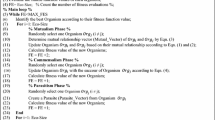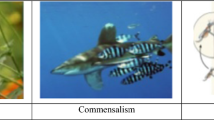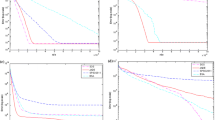Abstract
This paper proposes a new symbiotic evolutionary algorithm to solve complex optimization problems. This algorithm imitates the natural evolution process of endosymbionts, which is called endosymbiotic evolutionary algorithm. Existing symbiotic algorithms take the strategy that the evolution of symbionts is separated from the host. In the natural world, prokaryotic cells that are originally independent organisms are combined into an eukaryotic cell. The basic idea of the proposed algorithm is the incorporation of the evolution of the eukaryotic cells into the existing symbiotic algorithms. In the proposed algorithm, the formation and evolution of the endosymbionts is based on fitness, as it can increase the adaptability of the individuals and the search efficiency. In addition, a localized coevolutionary strategy is employed to maintain the population diversity. Experimental results demonstrate that the proposed algorithm is a promising approach to solving complex problems that are composed of multiple sub- problems interrelated with each other.
Similar content being viewed by others
Explore related subjects
Discover the latest articles, news and stories from top researchers in related subjects.References
D.E. Goldberg, Genetic Algorithms in Search, Optimization, and Machine Learning, Addison-Wesley: Massachusetts, 1989.
M.A. Potter, “The design and analysis of a computational model of cooperative coevolution,” Ph.D. dissertation, George Mason University, 1997.
D.E. Moriarty and R. Miikkulainen, “Forming neural networks through efficient and adaptive coevolution,” Evolutionary Computation, vol. 5, pp. 373-399, 1997.
L. Bull and T.C. Fogarty, “Artificial symbiogenesis,” Artificial Life, vol. 2, pp. 269-292, 1995.
W.D. Hillis, “Co-evolving parasites improve simulated evolution as an optimization procedure,” Physica D, vol. 42, pp. 228-234, 1990.
C.D. Rosin and R.K. Belew, “New methods for competitive coevolution,” Evolutionary Computation, vol. 5, pp. 1-29, 1997.
S. Nolfi and D. Floreano, “Coevolving predator and prey robots: Do arms races arise in artificial evolution,” Artificial Life, vol. 4, pp. 311-335, 1998.
M.L. Maher and J. Poon, “Modelling design exploration as co-evolution,” Microcomputers in Civil Engineering, vol. 11, pp. 195-210, 1996.
L. Bull, “Evolutionary computing in multi-agent environments: Partners,” Proc. 7th International on Conference Genetic Algorithms, East Lansing, MI, pp. 370-377, 1997.
L. Margulis, Symbiosis in Cell Evolution, W.H. Freeman, San Francisco, 1981.
J. Lovelock and L. Margulis, “Dr. Lynn Margulis: Microbiological collaboration of Gaia,” http://www.magan.com.au/ ~prfbrown/gaia lyn.html, Mountain Man Graphics, Australia, 1996.
N.A. Campbell, L.G. Mitchell, and J.B. Reece, Biology: Concepts & Connections, 2nd ed., Benjamin/Cummings Publishing Company Inc., Redwood City, CA, 1996.
Y.K. Kim, J.Y. Kim, and Y. Kim, “Analysis of partnering strategies in symbiotic evolutionary algorithms,” Working Paper, Department of Industrial Engineering, Chonnam National University, Korea, 1999.
G. Syswerda, “A study of reproduction in generational and steady-state genetic algorithms,” Foundations of Genetic Algorithms, edited by Gregory J.E. Rawlins, San Mateo, CA, pp. 94-101, 1991.
S.A. Kauffman and S. Johnsen, “Co-evolution to the edge of chaos: Coupled fitness landscapes, poised states and coevolutionary avalanches,” Artificial Life II: Proc. of an Interdisciplinary Workshop on the Synthesis and Simulation of Living Systems, Redwood City, CA, pp. 325-370, 1989.
S.A. Kauffman, The Origins of Order: Self-Organization and Selection in Evolution, Oxford University Press, New York, Oxford, 1993.
Y.K. Kim, J.Y. Kim, and Y. Kim, “A coevolutionary algorithm for balancing and sequencing in mixed model assembly lines,” Applied Intelligence, vol. 13, pp. 247-258, 2000.
Y. Davidor, “A naturally occurring niche and species phenomenon: The model and first results,” Proc. 4th International on Conference Genetic Algorithms, San Mateo, CA, pp. 257-263, 1991.
H.J.C. Barbosa, “A coevolutionary genetic algorithm for a game approach to structural optimization,” Proc. 7th International on Conference Genetic Algorithms, East Lansing, MI, pp. 545-552, 1997.
Author information
Authors and Affiliations
Rights and permissions
About this article
Cite this article
Kim, J.Y., Kim, Y. & Kim, Y.K. An Endosymbiotic Evolutionary Algorithm for Optimization. Applied Intelligence 15, 117–130 (2001). https://doi.org/10.1023/A:1011279221489
Issue Date:
DOI: https://doi.org/10.1023/A:1011279221489




